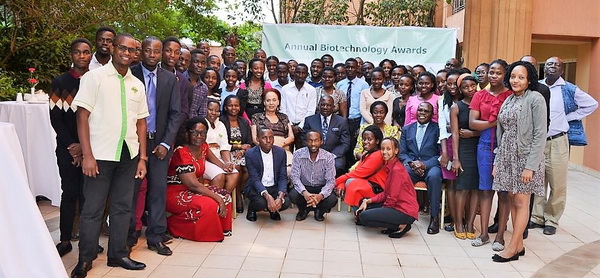
CROP BIOTECH UPDATE
---------------------------------------------------------------------------
A weekly summary of world developments in agri-biotech for developing countries, produced by the Global Knowledge Center on Crop Biotechnology, International Service for the Acquisition of Agri-biotech Applications SEAsiaCenter (ISAAA)
---------------------------------------------------------------------------
October 10, 2018
In This Week’s Issue:
News
Africa
Biotech Has Huge Potential to Transform Uganda's Growth, Minister Says
Americas
Gene Controlling Stem Juiciness in Sorghum Identified
Gene-edited Soybeans Being Harvested in the US
Survey: Most Americans Remain Confused About GMOs
CRISPR-Cas9 Triple Gene Edited Camelina Plant Receives Nonregulated Status
Asia and the Pacific
Biotech Maize to Boost Maize Supply in Pakistan
Researchers Modify Plant Walls to Make Biofuel Production Easier
Europe
Research Reveals Central Signal Sorting Hub in Plants
Eustice: Gene-edited Crops Are Necessary
Research
Scientists Develop Transgenic Potato with Enhanced Tuber Quality and Stress Tolerance
Cotton Gene Reduces Plant Sensitivity to Stress at Seedling Stage
Scientists Report Functional Characterization of a Soybean Galactinol Synthase Gene Under Stress Conditions
New Breeding Technologies
Scientists Show that Genome-editing is Highly Specific in Cotton
Stable, Heritable Gene Edits in Wheat Can Be Produced in 36 Weeks
Scientists Develop Easy Visual Screening of CRISPR-edited Strawberry and Soybean
Researchers Develop a Versatile Vector Toolkit Applicable in Rice Gene-editing
Beyond Crop Biotech
Genes Responsible for Snapdragon Flower Color Identified
25 UK Species' Genomes Sequenced
----
NEWS
----
Africa
BIOTECH HAS HUGE POTENTIAL TO TRANSFORM UGANDA'S GROWTH, MINISTER SAYS
Uganda has a hugely untapped but promising potential of biotechnology for her growth, said Hon. Dr. Elioda Tumwesigye, the country's Minister of Science, Technology and Innovations. The minister was categorical that bio-economy has greater potential to bring Uganda more money than oil.
Hon. Tumwesigye made the remarks while presiding over the Annual Biotechnology Science Awards organized by the Uganda Biotechnology and Biosafety Consortium (UBBC) on September 19, 2018. Erastus Nsubuga, UBBC's chair, echoed the minister's sentiments, saying investing in science will go a long way in supporting the development of a bio-economy.
Hans Peter Christopersen, who represented the Norwegian Ambassador at the awards, identified biotechnology as key in making agriculture more efficient and competitive. "Uganda has a very rich agricultural potential that ranges from crops to fish and animals but remains largely unexploited because of the reliance on outdated farming practices," he observed.
During the event, the most outstanding biotechnology innovators, entrepreneurs and communicators were feted for promoting biotechnology research and development in the country.

For more information about UBBC, contact Grace Prospero on prospero.ocheng@ubbconsortium.org.
Scientists at the Chinese Academy of Sciences have discovered the gene controlling the stem juiciness trait in sorghum from a diverse selection of sorghum varieties.
Sorghum is the world's fifth most popular crop. Grain sorghum, a tough, drought tolerant plant with dry, brittle stems, is used to make products ranging from animal feed to industrial chemicals to gluten-free flour, and is a promising source of biofuels. The less common juicy-stemmed sweet sorghum varieties are used to produce a maple syrup-like product.
The scientists discovered the Dry gene functions as a master switch that controls the expression of many genes that help determine the shape and composition of the plant cell wall. Mutations in the Dry gene in juicy-stemmed sorghum varieties lead to abnormal cell walls and even cell collapse, but the high sugar content in these plants enhances their growth and could lead to increased grain production. The scientists identified similar genes in other crop species, providing the opportunity to shape the level of stem juiciness in other plants as well.
For more details, read the press release from the American Society of Plant Biologists.
Farmers in three US states are harvesting 16,000 acres (~6,475 hectares) of soybeans developed through gene editing technique. The soybeans are expected to be sold to consumers for use in frying oil, salad dressings, and granola bars. It is the first commercialized crop in the US developed using the new promising technique.
In March 2018, US Agriculture Secretary, Sonny Perdue, issued a statement that products of new breeding innovations such as genome editing will not be regulated because there are no risks present in using the techniques. According to Perdue, the new techniques expand traditional plant breeding tools because they can introduce new characteristics precisely and rapidly, making improved crops available to farmers earlier than using other techniques.
Read more from BIO SmartBrief.
 Most Americans remain confused about genetically modified organisms (GMOs), but want to learn more about the technology, according to a survey by YouGov.
Most Americans remain confused about genetically modified organisms (GMOs), but want to learn more about the technology, according to a survey by YouGov.
The survey, conducted online in September 2018 and participated by 1,213 American adults, showed the following key findings:
"Despite GMOs being part of our food supply for almost a quarter of a century, and global scientific consensus on the health and safety of this technology, Americans remain as confused as ever about how GMOs impact their lives and the world around them," said Michael Stebbins, Director of External Engagement for the Council for Biotechnology Information (CBI) and GMO Answers spokesperson. However, it was also emphasized that concern and confusion are not equal to to rejection, as the survey finds that nearly the same number of respondents are interested to know more about GMOs.
Read more from GMO Answers.
 Genome-edited Camelina sativa plant lines developed by Yield10 Bioscience, Inc. using CRISPR-Cas9 for increased oil content has received nonregulated status from the USDA Animal and Plant Health Inspection Service (USDA APHIS)'s Biotechnology Regulatory Services (BRS).
Genome-edited Camelina sativa plant lines developed by Yield10 Bioscience, Inc. using CRISPR-Cas9 for increased oil content has received nonregulated status from the USDA Animal and Plant Health Inspection Service (USDA APHIS)'s Biotechnology Regulatory Services (BRS).
Yield10 submitted an "Am I Regulated?" letter to the BRS in May 2018, requesting confirmation of the regulatory status for Camelina plant lines containing combinations of genetic changes to increase oil production based on three gene traits: C3008a, C3008b, and C3009. The response from USDA-APHIS is published in a letter indicating that the plant lines do not meet the definition of a regulated article under 7 CFR Part 340. Yield10 believes that this is the first triple genome-edited plant to receive nonregulated status from USDA-APHIS.
Yield10 has conducted studies in the greenhouse and preliminary results suggest that the triple-edited Camelina lines may have the potential to increase oil content and to improve oil quality. Yield10 intends to study these plant lines in field tests planned for 2019 in the U.S. as part of its development program to increase oil and seed yield in Camelina and canola for specialty oils applications.
For more details, read the news release from Yield10 or read the BRS response.
According to a study, the commercialization of biotech maize in Pakistan is expected to boost the maize productivity in the country. It is projected that the rapid adoption of biotech maize in Pakistan beginning in 2019 will deliver around US$1 billion additional benefits to farmers, laborers, brokers, and grains industry in the next 10-year period.
In 2016, single and stacked biotech maize expressing insect resistance and herbicide tolerance traits were officially approved for commercial cultivation by the National Bio-safety Committee (NBC) of the Ministry of Climate Change (MOCC). As part of the regulatory requirement for varietal registration by the Federal Seed Certification and Registration Department, Ministry of National Food Security and Research in 2017-18, the field performance trials of biotech maize hybrids were conducted.
Read more details from Pakissan.
Scientists from the University of Melbourne showed how plant walls could be modified to change the way how biofuels, bioplastics, and other biomaterials are produced. Their study is published in Nature Plants.
The researchers used master switches that can switch on primary wall production. It was found that the switches can make cell produce thick primary walls that can even be used to replace secondary walls. The study proved that scientists may entirely change the content of plant biomass from strong and hard to break apart into something more plastic and easy to dissolve.Read more details from Biofuels Digest and Nature Plants.
A research study has revealed the central signal sorting hub that plants use to coordinate biological processes. Dr. Vinod Kumar of the John Innes Centre (JIC) said that their research has revealed the existence of a central signal sorting hub, which fine tunes plant growth and immunity in line with key seasonal cues.
Using Arabidopsis, the JIC research team found two key proteins, DET1 and COP1, at the center of this signaling hub. The proteins are known for their role in light signalling and growth control. This study has shown a new role of these proteins in plant defense. DET1 and COP1 along with the transcription factor PIF4 control the coordination of growth and immunity in response to day length and temperature.
For more details, read the JIC news release.
 Gene-edited crops are necessary if UK is serious about trying to decrease the use of chemical pesticides, according to Department of Environment, Food, and Rural Affairs (Defra) Minister, George Eustice. He said this statement in response to the letter addressed to him by a group of scientists and industry leaders, which demanded clarity on how the UK Government's 'Chequers' Brexit plan would affect gene editing research. The letter was sent after the European Court of Justice declared that gene editing should be subject to the same regulations implemented to genetic modification.
Gene-edited crops are necessary if UK is serious about trying to decrease the use of chemical pesticides, according to Department of Environment, Food, and Rural Affairs (Defra) Minister, George Eustice. He said this statement in response to the letter addressed to him by a group of scientists and industry leaders, which demanded clarity on how the UK Government's 'Chequers' Brexit plan would affect gene editing research. The letter was sent after the European Court of Justice declared that gene editing should be subject to the same regulations implemented to genetic modification.
"We disagree with the judgement the ECJ has come up with. We think gene editing and cisgenesis is largely an extension of conventional breeding techniques, the likes of which we have had for decades," said Eustice on behalf of Defra."It is already the case that GM foods are widely sold in the EU, particularly in animal feed, where they predominate, even though the EU does not allow the cultivation of crops...As a decision, it is very much a national one, not affected by the common rule book," he emphasized.
Read the original article from The Scottish Farmer.
ABF proteins are transcription factors that are involved in abscisic acid signalling when stress is present and are important in the induction of tuberization. ABF4 has been found to be important in tuber yield. In the study mentioned, the researchers generated transgenic potato with the ABF4 gene via Agrobacterium-mediated transformation. They determined the tuber dry matter content and starch and sugar content, sprouting behavior, leaf water loss, relative water content of the transgenic plants. Under salinity and drought conditions, they also determined agronomic traits, proline content, protein oxidation, gas exchange, and chlorophyll content of transgenic potato plants. Results showed enhanced salinity and drought tolerance and increase in tuber yield in potato plants under normal and stressed conditions. The tubers were also shown to have enhanced storage capability and processing quality.
For more information, read the article in Plant Molecular Biology.
Seed germination and seedling establishment in cotton, the most important crop used globally for fiber and oil, are impaired by abiotic stresses. PLATZ proteins, which are zinc-finger transcription factors involved in plant abiotic stress responses, are present in cotton, but studies about them are limited.
Researchers from Shandong Agricultural University in China investigated the biological and physiological functions of the cotton gene GhPLATZ by expressing it in Arabidopsis via Agrobacterium-mediated transformation. They determined the gene expression of the transgene and proceed to the analysis of seed germination and cotyledon greening and abscisic acid (ABA) content. Results showed that with the increased expression of the gene in the transgenic plant, seed germination was faster, and seed establishment was higher under salt- and mannitol-stressed conditions. The gene expression is considered to be mediated by ABA, gibberellin, and ethylene pathways.
For more information, read the article in BMC Plant Biology.
Galactinol synthase (GolS) has been known to play a key role in raffinose biosynthesis by catalyzing the formation of galactinol. The GolS gene family has been recently identified in various plant species. Among them, many individual GolS genes have been reported to function in plant stress tolerance.
The researchers reported the construction of transgenic Arabidopsis overexpressing a soybean GolS gene, GolS2. There were no significant differences in the phenotypes of the transgenic and control plants during normal physiological conditions. The performance of the transgenic plants was evaluated under various stress conditions in relation to that of the control plants. The result showed that the overexpression of GmGolS2 gene in Arabidopsis improved the plant's tolerance to salt stress, but did not protect the plants against heavy metals and paraquat. The study suggested that soybean GolS genes could be a potential candidate for genetic engineering to improve abiotic stress tolerance of plants.
For more information, read the article in Vietnam Journal of Science, Technology, and Engineering.
To give an insight on the usability of CRISPR-Cas9 in cotton, researcher Shuangxia Jin from Huazhong Agricultural University and colleagues determined the specificity of the technology through whole genome sequencing. They targeted three genes in cotton using CRISPR-Cas9 and evaluated off-targets thereafter using 14 edited plants and three wild types for sequencing. Results showed that the variations found in the sequences are mostly due to natural variation and tissue culture effects and not due to off-targets. These results show that the CRISPR-Cas9 system is highly specific in cotton and can be used in improving the crop.
For more information, read the article in Plant Biotechnology.
Scientists from The John Bingham Laboratory in UK used Agrobacterium-mediated transformation to incorporate the gene-editing system in wheat and targeted the TaPDS gene. Results showed 11 to 17 percent efficiency for single-gene targeting and five percent efficiency for tri-genome targeting. The scientists concluded that transgene-free wheat lines edited for a specific gene can be ideally developed within 36 weeks using this method.
For more information, read the article in BMC Plant Biology.
In the new study, they inserted a fluorescence tag to the original vector that they used in editing rapeseed. The new vector is tested in different dicot plants, including rapeseed, soybeans, Arabidopsis, and strawberry. High editing frequencies were achieved particularly in strawberry (95%) and soybeans (75%). This method is an efficient tool to readily identify positive transformants in a wide range of dicot species.
For more information, read the article in Frontiers in Plant Science.
Researcher Guo-Liang Wang from Chinese Academy of Agricultural Sciences and colleagues develop a vector toolkit, which include 42 vectors for transient and stable expression experiments in rice. They analyzed recognition sites in rice coding sequences and developed a universal multiple cloning site that can be applied to more than 99 percent of rice coding sequences. They tested these vectors in several assays such as CRISPR-Cas9 mediated editing of rice plants and obtained high editing efficiencies.
For more information, read the article in Rice.
Snapdragons are charming tall plants, flowering in a variety of bright colors. However, snapdragon flower colors do not mix, even if they are growing together in a wide area, and this has baffled scientists for a long time.
Researchers from the Institute of Science and Technology Austria (IST Austria and John Innes Center in Norwich compared the genome sequence of 50 snapdragons of each color, and measured how much the sequences diverged between magenta and yellow snapdragon populations. They found "islands" in the genome, which are more divergent between yellow and magenta snapdragons than the rest of the genome. These islands correspond to genes responsible for flower color.
The researchers found two reasons why the snapdragon populations diverge at the flower color genes. Firstly, selection has favored new variants at the color genes, making the flowers more attractive to bees, causing these genes to sweep through the population, and leaving a sharp signal in the DNA sequences. Secondly, the flower genes become barriers to gene exchange. Genes located close to or even between the flower genes cannot easily be swapped between the populations, and so the region of genome around the genes that determine flower color become divergent.
For more details, read the news details from IST Austria.
The Wellcome Sanger Institute and their collaborators have sequenced the full genomes of 25 species from the United Kingdom for the first time. The DNA sequence of these plants and animals, including birds, fish, and insects will help biologists and conservationists understand more about how they live and how to protect them. The high-quality genomes will be made freely available to scientists.
According to the Sanger Institute, the newly-sequenced genomes will enable research into why some brown trout migrate to the open ocean, whilst others don't, or investigations into the magneto receptors in robins' eyes that allow them to see' the magnetic fields of the Earth. The genomes could also help to shed light on why red squirrels are vulnerable to the squirrel pox virus, yet grey squirrels can carry and spread the virus without becoming ill.
The 25 Genomes Project is part of the Wellcome Sanger Institute's wider 25th Anniversary celebrations. The 25 genomes represent five key areas of biodiversity in Britain.
To see the list of the 25 species, and the partners of the Sanger Institute in this research, read their news release.